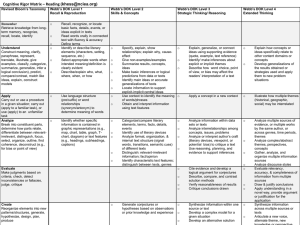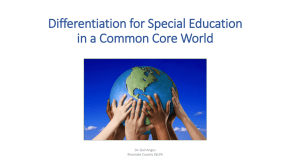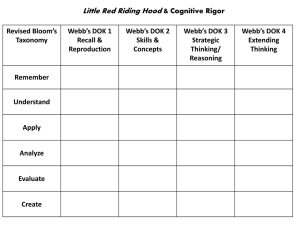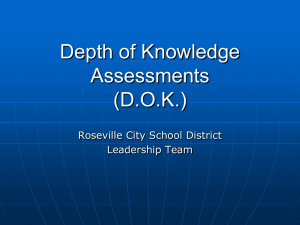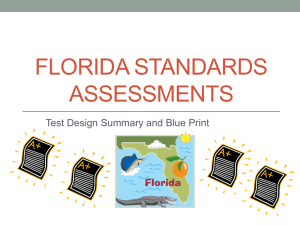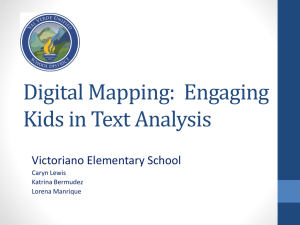Aligning IEP`s to the CCSS Presentation
advertisement
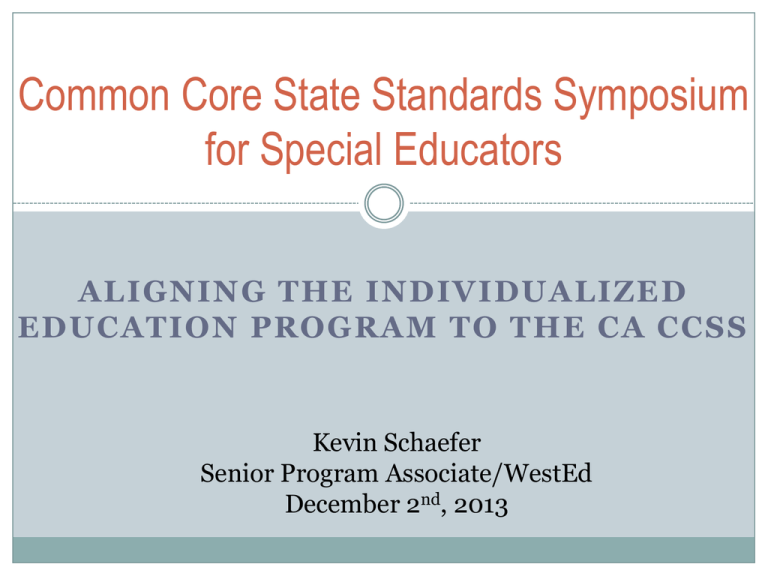
Common Core State Standards Symposium for Special Educators ALIGNING THE INDIVIDUALIZED EDUCATION PROGRAM TO THE CA CCSS Kevin Schaefer Senior Program Associate/WestEd December 2nd, 2013 College/Career Readiness Anchor Standards FAPE in the LRE Bloom’s Taxonomy Universal Design for Learning Educational Benefit Progress Indicators Standards for Mathematical Practices Webb’s Depth of Knowledge Learning Targets Common Core State Standards Hess’ Cognitive Rigor Matrix Individualized Goals and Objectives “To pursue the bright spots is to ask the question, ‘What’s working, and how can we do more of it?’” NCSC’s Commitment to Communicative Competence Communication at some level is possible and identifiable for all students regardless of functional “level,” and is the starting point for developing communicative competence. Communication competence is defined as the use of a communication system that allows students to gain and demonstrate knowledge. Many people with severe speech or language problems rely on alternative forms of communication, including augmentative and alternative communication (AAC) systems, to use with existing speech or replace difficult to understand speech. NCSC Parent Materials September 2013. http://www.ncscpartners.org/Media/Default/PDFs/Resources/Parents/NCSC-CommunicativeCompetence-9-10-13.pdf IEP Alignment Formative Assessment Gets Us Where We Want to Go “Formative assessment – encompasses all those activities undertaken by teachers, and/or by their students, which provide information to be used as feedback to modify the teaching and learning activities are engaged.” “An assessment functions formatively to the extent that evidence about student achievement is elicited, interpreted, and used by teachers, learners, or their peers to make decisions about the next steps in instruction that are likely to be better, or better founded, than the decisions they would have made in the absence of that evidence.” Educational Benefit and the IEP When writing goals and objectives, ask: “How will the student demonstrate mastery?” • Given What • Under What Conditions • With which adaptations Individualize goals and objectives by: “How will the student demonstrate mastery?” • Unpack it • Combine it • Verb it Individualize goals and objectives by: “How will the student demonstrate mastery?” • Increase independence • Decrease support (appropriately) • Trellis An integrated model of literacy Although the Standards are divided into Reading, Writing, Speaking and Listening, and Language strands for conceptual clarity, the processes of communication are closely connected, as reflected throughout this document. For example, Writing standard 9 requires that students be able to write about what they read. Likewise, Speaking and Listening Standard 4 sets the expectation that students will share findings from their research. -Sacramento County of Education CCSS Document p. 3 CCSS RL – Integrated Literacy • • • • • • • Find references to “prompting and support” RL.K-12.4: reference to L.K-12.4-6 RL.K-2.5: differentiates between RL and RI RL.K-5.8: is not applicable RL.3&4.5: integrates writing and speaking RL.2.6: integrates speaking RL.4.7: integrates speaking (oral presentation receptive language) • Note executive functions and ask, “under what conditions will the student demonstrate mastery? CCSS RI – Integrated Literacy • RI.K-12.4: reference to L.K-12.4-6 • RI.4-12.7: integrates listening (info. orally presented) • RI.4&5.9: integrates writing and speaking • RI.2-5.10: integrates history/social studies, science and technical texts • Note executive functions and ask, “under what conditions will the student demonstrate mastery?” CCSS RF – Integrated Literacy • RF.K.1-3: note emphasis on spoken words/ phonemic awareness • RF.1.2: note the emphasis on spoken words/ phonemic awareness • RF.1-5.3&4: note progression from spoken words/ phonemic awareness to spelling/sound relationships to decoding/reading • Consider language-based disabilities (auditory processing) when addressing phonemic awareness CCSS W – Integrated Literacy • Find references to “guidance and support” • W.K-12.1-3: lists types of writing as 1.opinion/argument; 2.informative/explanatory; 3.narrative • W.6-12.1: “opinion” pieces change to “argument” • W.2-12.4: references “Grade-specific expectations for writing types are defined in writing standards 1-3” • W.3-12.5: references “Editing for conventions should demonstrate command of L standards 1-3” • Reading expectations are included: W.3-12.8 and W.412.9 • Executive functions are numerous and critical CCSS SL – Integrated Literacy • Reading expectations are included: SL.3-12.1 • Writing (fine motor) expectations are included: SL.K-5.5 • Language expectations are included: SL.1-12.6 • Consider language-based disabilities (auditory processing) when addressing oral, i.e., expressive/receptive language • Executive functions are numerous and critical CCSS L – Integrated Literacy • Reading AND speaking expectations are included: L.K-12.1 • Writing/spelling expectations are included: L.K12.2 • Reading, writing, AND speaking and listening expectations are included: L.2-12.3 and L.9-12.6 • Reading and speaking and listening expectations are included: L.K-3.6 • Executive functions are numerous and critical Prompting https://wiki.ncscpartners.org/mediawiki/index.php/Instructional_Resource_Guide BLOOM’S TAXONOMY Remembering Understanding Applying Analyzing Can the student distinguish between the different parts? Can the student recall or remember the info.? Can the student explain ideas or concepts? Can the student use the info. in a new way? define duplicate list memorize recall repeat reproduce state classify describe discuss explain identify locate recognize report select translate paraphrase choose demonstrate dramatize employ illustrate interpret operate schedule sketch solve use write. appraise compare contrast criticize differentiate discriminate distinguish examine experiment question test Evaluating Creating Can the student justify a stand or decision? Can the student create new product or point of view? appraise argue defend judge select support value evaluate assemble, construct create design develop formulate write CCSS – Depth of Knowledge Focuses on complexity of content standards in order to successfully complete an assessment or task. The outcome (product) is the focus of the depth of understanding. The Depth of Knowledge is NOT determined by the verb (Bloom’s Taxonomy), but by the context in which the verb is used and the depth of thinking required. CCSS – Depth of Knowledge An example: DOK 1- Describe three characteristics of metamorphic rocks. (Requires simple recall) DOK 2- Describe the difference between metamorphic and igneous rocks. (Requires cognitive processing to determine the differences in the two rock types) DOK 3- Describe a model that you might use to represent the relationships that exist within the rock cycle. (Requires deep understanding of rock cycle and a determination of how best to represent it) CCSS – Depth of Knowledge It’s about what follows the verb, i.e., what comes after the verb is more important than the verb itself. Analyze this sentence to decide if the commas have been used correctly” does not meet the criteria for high cognitive processing. The student who has been taught the rule for using commas is merely using the rule. http://www.aps.edu/rda/documents/resources/Webbs_DOK_Guide.pdf DEPTH OF KNOWLEDGE LEVELS (The Depth of Knowledge is not determined by the verb, but what comes after the verb and the context in which the verb is used, i.e., the depth of thinking required. Level 1: Recall and Reproduction Requires recall of information, such as a fact, definition, term, or performance of a simple process or procedure. Answering a level 1 item involves following a simple, well-known procedure or formula. Simple skills and abilities or recall characterize this level. Level 2: Skills/Concepts Includes the engagement of some mental processing beyond recalling or reproducing a response. Items require students to make some decisions as to how to approach the question or problem. These actions imply more than one mental or cognitive process/step. Level 3: Strategic Thinking: Requires deep understanding as exhibited through planning, using evidence, and more demanding cognitive reasoning. The cognitive demands at this level are complex and abstract. An assessment item that has more than one possible answer and requires students to justify the response they give would most likely be a Level 3. Level 4: Extended Thinking Requires high cognitive demand and is very complex. Students are expected to make connections – relate ideas within the content or among content areas – and have to select or devise one approach among many alternatives on how the situation can be solved. Due to the complexity of cognitive demand, this level often requires an extended period of time. Depth of Knowledge Activities Cognitive Rigor Matrix – Reading (khess@nciea.org) Revised Bloom’s Taxonomy Webb’s DOK Level 1 Recall & Reproduction Remember o Recall, recognize, or locate Retrieve knowledge from longbasic facts, details, events, or ideas explicit in texts term memory, recognize, recall, locate, identify o Read words orally in connected text with fluency & accuracy o Define terms Understand o Identify or describe literary Construct meaning, clarify, elements (characters, setting, sequence, etc.) paraphrase, represent, translate, illustrate, give o Select appropriate words when examples, classify, categorize, intended meaning/definition is clearly evident summarize, generalize, infer a logical conclusion), predict, o Describe/explain who, what, where, when, or how compare/contrast, match like ideas, explain, construct models Webb’s DOK Level 2 Skills & Concepts Webb’s DOK Level 3 Strategic Thinking/ Reasoning Webb’s DOK Level 4 Extended Thinking o o Explain, generalize, or connect ideas using supporting evidence (quote, example, text reference) Identify/ make inferences about explicit or implicit themes Describe how word choice, point of view, or bias may affect the readers’ interpretation of a text o Use context to identify the meaning o of words/phrases Obtain and interpret information using text features Apply a concept in a new context o Illustrate how multiple themes (historical, geographic, social) may be interrelated o Analyze information within data sets or texts Analyze interrelationships among concepts, issues, problems Analyze or interpret author’s craft (literary devices, viewpoint, or potential bias) to critique a text Use reasoning, planning, and evidence to support inferences o Analyze multiple sources of evidence, or multiple works by the same author, or across genres, time periods, themes Analyze complex/abstract themes, perspectives, concepts Gather, analyze, and organize multiple information sources Analyze discourse styles o o o o o Apply Carry out or use a procedure in a given situation; carry out (apply to a familiar task), or use (apply) to an unfamiliar task Analyze Break into constituent parts, determine how parts relate, differentiate between relevantirrelevant, distinguish, focus, select, organize, outline, find coherence, deconstruct (e.g., for bias or point of view) o o Use language structure (pre/suffix) or word relationships (synonym/antonym) to determine meaning of words o Identify whether specific information is contained in graphic representations (e.g., map, chart, table, graph, Tchart, diagram) or text features (e.g., headings, subheadings, captions) o o o o o o Specify, explain, show relationships; explain why, causeeffect Give non-examples/examples Summarize results, concepts, ideas Make basic inferences or logical predictions from data or texts Identify main ideas or accurate generalizations of texts Locate information to support explicit-implicit central ideas Categorize/compare literary elements, terms, facts, details, events Identify use of literary devices Analyze format, organization, & internal text structure (signal words, transitions, semantic cues) of different texts Distinguish: relevant-irrelevant information; fact/opinion Identify characteristic text features; distinguish between texts, genres o o o o o o o o Generate conjectures or hypotheses based on observations or prior knowledge and experience o o o o o Evaluate Make judgments based on criteria, check, detect inconsistencies or fallacies, judge, critique Create Reorganize elements into new patterns/structures, generate, hypothesize, design, plan, produce o o o o Cite evidence and develop a logical argument for conjectures Describe, compare, and contrast solution methods Verify reasonableness of results Critique conclusions drawn o Synthesize information within one source or text Develop a complex model for a given situation Develop an alternative solution o o o o Explain how concepts or ideas specifically relate to other content domains or concepts Develop generalizations of the results obtained or strategies used and apply them to new problem situations Evaluate relevancy, accuracy, & completeness of information from multiple sources Draw & justify conclusions Apply understanding in a novel way, provide argument or justification for the application Synthesize information across multiple sources or texts Articulate a new voice, alternate theme, new knowledge or perspective Cognitive Rigor Matrix – Writing (khess@nciea.org) Revised Bloom’s Taxonomy Webb’s DOK Level 1 Recall & Reproduction Webb’s DOK Level 2 Skills & Concepts Webb’s DOK Level 3 Strategic Thinking/ Reasoning Webb’s DOK Level 4 Extended Thinking Understand Construct meaning, clarify, paraphrase, represent, translate, illustrate, give examples, classify, categorize, summarize, generalize, infer a logical conclusion), predict, compare/contrast, match like ideas, explain, construct models Apply Carry out or use a procedure in a given situation; carry out (apply to a familiar task), or use (apply) to an unfamiliar task o o Specify, explain, show relationships; explain why, causeeffect Give non-examples/examples Take notes; organize ideas/data Summarize results, concepts, ideas Identify main ideas or accurate generalizations of texts o Explain, generalize, or connect ideas using supporting evidence (quote, example, text reference) Write multi-paragraph composition for specific purpose, focus, voice, tone, & audience o Use context to identify the meaning of words/phrases Obtain and interpret information using text features Develop a text that may be limited to one paragraph Apply simple organizational structures (paragraph, sentence types) in writing o Revise final draft for meaning or progression of ideas Apply internal consistency of text organization and structure to composing a full composition Apply a concept in a new context Apply word choice, point of view, style to impact readers’ interpretation of a text o Analyze Break into constituent parts, determine how parts relate, differentiate between relevantirrelevant, distinguish, focus, select, organize, outline, find coherence, deconstruct (e.g., for bias, point of view) o Compare literary elements, terms, facts, details, events Analyze format, organization, & internal text structure (signal words, transitions, semantic cues) of different texts Distinguish: relevant-irrelevant information; fact/opinion o Analyze interrelationships among concepts, issues, problems Apply tools of author’s craft (literary devices, viewpoint, or potential dialogue) with intent Use reasoning, planning, and evidence to support inferences made o Remember Retrieve knowledge from longterm memory, recognize, recall, locate, identify o o Describe or define facts, details, terms Select appropriate words to use when intended meaning/definition is clearly evident Write simple sentences o o o o o o Apply rules or use resources to o edit specific spelling, grammar, punctuation, conventions, word o use Apply basic formats for o documenting sources o Decide which text structure is appropriate to audience and purpose o o o o o o o o o o o o o o Evaluate Make judgments based on criteria, check, detect inconsistencies or fallacies, judge, critique Create Reorganize elements into new patterns/structures, generate, hypothesize, design, plan, produce o o o o Brainstorm ideas, concepts, problems, or perspectives related to a topic or concept o Generate conjectures or hypotheses based on observations or prior knowledge and experience o o Cite evidence and develop a logical argument for conjectures Describe, compare, and contrast solution methods Verify reasonableness of results Justify or critique conclusions o Develop a complex model for a given situation Develop an alternative solution o o o o Explain how concepts or ideas specifically relate to other content domains or concepts Develop generalizations of the results obtained or strategies used and apply them to new problem situations Select or devise an approach among many alternatives to research a novel problem Illustrate how multiple themes (historical, geographic, social) may be interrelated Analyze multiple sources of evidence, or multiple works by the same author, or across genres, or time periods Analyze complex/abstract themes, perspectives, concepts Gather, analyze, and organize multiple information sources Evaluate relevancy, accuracy, & completeness of information from multiple sources Draw & justify conclusions Apply understanding in a novel way, provide argument or justification for the application Synthesize information across multiple sources or texts Articulate a new voice, alternate theme, new knowledge or perspective Cognitive Rigor Matrix – Math and Science (khess@nciea.org) Revised Bloom’s Taxonomy Webb’s DOK Level 1 Recall & Reproduction Remember o Recall, observe, & recognize facts, principles, properties Retrieve knowledge from longterm memory, recognize, o Recall/ identify conversions recall, locate, identify among representations or numbers (e.g., customary and metric measures) Understand Construct meaning, clarify, paraphrase, represent, translate, illustrate, give examples, classify, categorize, summarize, generalize, infer a logical conclusion (such as from examples given), predict, compare/contrast, match like ideas, explain, construct models o o Apply Carry out or use a procedure in a given situation; carry out (apply to a familiar task), or use (apply) to an unfamiliar task o o o o Webb’s DOK Level 3 Strategic Thinking/ Reasoning Webb’s DOK Level 4 Extended Thinking o Specify and explain relationships (e.g., non-examples/examples; cause-effect) Make and record observations Explain steps followed Summarize results or concepts Make basic inferences or logical predictions from data/observations Use models /diagrams to represent or explain mathematical concepts Make and explain estimates o Use concepts to solve non-routine problems Explain, generalize, or connect ideas using supporting evidence Make and justify conjectures Explain thinking when more than one response is possible Explain phenomena in terms of concepts o Select a procedure according to criteria and perform it Solve routine problem applying multiple concepts or decision points Retrieve information from a table, graph, or figure and use it solve a problem requiring multiple steps Translate between tables, graphs, words, and symbolic notations (e.g., graph data from a table) Construct models given criteria o Design investigation for a specific purpose or research question Conduct a designed investigation Use concepts to solve non-routine problems Use & show reasoning, planning, and evidence Translate between problem & symbolic notation when not a direct translation o Categorize, classify materials, data, figures based on characteristics Organize or order data Compare/ contrast figures or data Select appropriate graph and organize & display data Interpret data from a simple graph Extend a pattern o Compare information within or across data sets or texts Analyze and draw conclusions from data, citing evidence Generalize a pattern Interpret data from complex graph Analyze similarities/differences between procedures or solutions o Cite evidence and develop a logical argument for concepts or solutions Describe, compare, and contrast solution methods Verify reasonableness of results o Synthesize information within one data set, source, or text Formulate an original problem given a situation Develop a scientific/mathematical model for a complex situation o o o o o o o o o o o Analyze Break into constituent parts, determine how parts relate, differentiate between relevantirrelevant, distinguish, focus, select, organize, outline, find coherence, deconstruct Evaluate an expression Locate points on a grid or number on number line Solve a one-step problem Represent math relationships in words, pictures, or symbols Read, write, compare decimals in scientific notation Webb’s DOK Level 2 Skills & Concepts o o o Follow simple procedures (recipe-type directions) Calculate, measure, apply a rule (e.g., rounding) Apply algorithm or formula (e.g., area, perimeter) Solve linear equations Make conversions among representations or numbers, or within and between customary and metric measures o Retrieve information from a table or graph to answer a question Identify whether specific information is contained in graphic representations (e.g., table, graph, T-chart, diagram) Identify a pattern/trend o o o o o o o o o o o o o o o o o o o o o o o Evaluate Make judgments based on criteria, check, detect inconsistencies or fallacies, judge, critique o o Create Reorganize elements into new patterns/structures, generate, hypothesize, design, plan, construct, produce o Brainstorm ideas, concepts, or perspectives related to a topic o Generate conjectures or hypotheses based on observations or prior knowledge and experience o o o o o o o o o Relate mathematical or scientific concepts to other content areas, other domains, or other concepts Develop generalizations of the results obtained and the strategies used (from investigation or readings) and apply them to new problem situations Select or devise approach among many alternatives to solve a problem Conduct a project that specifies a problem, identifies solution paths, solves the problem, and reports results Analyze multiple sources of evidence analyze complex/abstract themes Gather, analyze, and evaluate information Gather, analyze, & evaluate information to draw conclusions Apply understanding in a novel way, provide argument or justification for the application Synthesize information across multiple sources or texts Design a mathematical model to inform and solve a practical or abstract situation What is Universal Design? What is Universal Design? Is our learning environment welcoming? UDL is the proactive design of curriculum and instruction to ensure they are educationally accessible regardless of learning style, physical or sensory abilities. Just as physical barriers exist in our physical environment, curricular barriers exist in our instructional environment. How is Universal Design Defined? The term UDL means a scientifically valid framework for guiding educational practice that: Provides flexibility in the ways information is presented (recognition), in the ways students respond or demonstrate knowledge and skills (action and expression), and in the ways students are engaged (engagement); and How is Universal Design Defined? The term UDL means a scientifically valid framework for guiding educational practice that: …reduces barriers in instruction, provides appropriate accommodations, supports, and challenges, and maintains high achievement expectations for all students, including students with disabilities and students who are English Language Learners. (Higher Education Opportunity Act of 2008) UDL In Action 53 http://www.cde.ca.gov/sp/se/cc/ http://www.corestandards.org/assets/application-to-students-with-disabilities.pdf http://www.smarterbalanced.org/parents-students/support-for-under-represented-students/ http://www.smarterbalanced.org/wordpress/wp-content/uploads/2013/09/SmarterBalanced_Guidelines_091113.pdf http://www.leadered.com/pdf/Special%20Ed%20&%20CCSS%20white%20paper.pdf http://www.ncscpartners.org/resources http://www.achievethecore.org/common-core-intro-for-parents “People don't buy what you do, they buy why you do it.” - Simon Sinek TEDTalk - How Great Leaders Inspire Action


